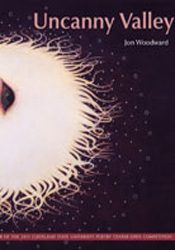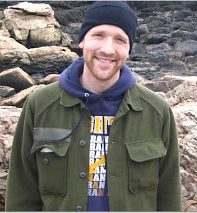
What does it mean to understand poetry? There are poems written in the 19th century – by Clare, say, or Keats – that still compel new interpretations. These poems are, however, to a certain extent “representational,” a word I loathe, so use hesitantly, as I’m not sure poems represent anything at all besides other poems. Yet while the poetic texture of a Keats or Clare poem seems forever to allow for new, varied and vivid interpretations, the texture itself seems to gesture towards meaningful parts of lived experience.
In other words, Clare or Keats is not Gertrude Stein. While both are just as intensely interested in language, in what words do on a page, and in bathing the familiar world in an unfamiliar light, I am not sure any poetry before Stein is as autotelic, as disassociated from the world, and as autistically preoccupied with the sound and texture and form and stutter of its own valved voice going where no poem has gone before.
Uncanny Valley by Jon Woodward, the winner of the 2011 Cleveland State University Poetry Center open competition, might be seen in the same light as Stein’s work. For Woodward is not interested in correspondence at all; or, if he is, he wants words to correspond to aspects of our experience that we haven’t thought about yet, or perhaps even imagined. Perhaps it is for this reason that his poems can be very musical, or at least sound-oriented – they have been composed and performed elsewhere along with music – a concert-length piano piece – and I can see why. Music itself is otherworldly, perhaps the strangest, the uncanniest of all the art forms. Occasionally, in Uncanny Valley, one is not sure if one is reading words so much as hearing sounds (what is the difference? Is there one?), an interesting reminder that, at least according to Hard Science Linguistics, what we are experiencing on the page is in fact just that: sound, phonetics, not semantics. Here is an excerpt from the first page of the poems proper, part of a longer poem called “Huge Dragonflies”:
Huge dragonflies aim at your face.
Hope dwells eternally there.
Hope dwells eternally there.
Sound waves define characterist
istics of every interpersonal action
Hope dwells eternally there.
Hope dwells eternally there.
Hope dwells eternally there.
Hope dwells eternally there.
Hope dwells eternally
Enough food not enough food
Hope dwells eternally there
Hope dwells eternally there.
The sound of a calm fizz
breaks and dissipates
with a touch on the bl
ind girl’s shoulder to
congratulate her, her exhalation
tion Hope dwells eternally there
Hope dwells eternally there
The passage ranges from fascinating to boring to creepy to maddening to puzzling. And it raises the question of interpretation – specifically, what do we do with this? How do we talk about such an object? Do we excavate it for glimmers of meaning? Do we try to take it on its own terms, somehow, someway, without sounding horridly lame? Some combination of the two? Perhaps we simply take it line-by-line. So: “Huge dragonflies aim at your face.” Not the happiest predicament to be in, but even with the first line, we can see how a kind of surreal and sonic landscape opens out. Reading the first line, we might hear the buzzing of the dragonflies just as much as we see them “aiming” at our face. The poem, like the dragonflies, is an assault on our imaginations. When we next read the weirdly ironic, weirdly sincere, baffling “Hope dwells eternally there,” it seems almost like the phrase, in its repetition, is as meaningless, mindless, meaningful, mindful and inevitable as dragonflies flying at one’s face, as advertisements for laundry detergent, as poems interested less in sense and more in sound. One almost imagines a portrait of a face, progressively erased or blocked out by the phrase, “Hope dwells eternally there.” As if one were repeating a phrase over and over again, to experience how the phrase loses its meaning and becomes a sonic object. This interpretation is perhaps not too far-fetched, for we next read, in a line that stutters to hear itself said, “Sound waves define characterist / istics of every interpersonal action.” Yes, we want to say, that’s it! The poem, this poem, is more interested in sound than meaning. But why? Is it because meaning is just that: sound? What are the benefits of such an orientation, and what are the drawbacks?
I suppose the benefits are that you have more leeway to explore that sonic world. You have a new slant towards language, a new way of “making meaning” that is not constrained by semantics, that is only constrained by the acrobatics of the ear. You can be an Elliot Carter of poetry. But what are the drawbacks? These poems can be alienating in their autistic progressions, without supplying the pleasure, say, of an early Ashbery poem. For example, here is the entirety of “Salamander,” a poem that works as a metaphor for the experience of reading the whole collection:
The janitor asked me
how to pronounce the creature’s name
& I said salamander for him.
He looked at it on the screen
and I looked at him.
Slide your legs into its tail I said.
I can’t he said as he did.
Feed your guts there into its cavity
of guts, I can’t he said (manifestly untrue
because he did). Mash the thing’s
name and yours I said together into
that irreversible hole I know you keep
and he did & it broke over his face
& flowed, water from the earth,
I can’t, I can’t, he said.
 It does not seem too much of a stretch to argue that we, the readers, are the janitor in most of Woodward’s poems in Uncanny Valley. We are the ones who do not know how to pronounce the names. Woodward, the poet, is the one who feeds us the names, the one who says “salamander” for us, and then forces us to contort our understanding in various awkward ways to fit his poetic understanding of the poem, the name, the salamander. What’s unclear is why this serves as Woodward’s poetic template throughout the collection. For who likes to be assaulted with language, or forced into contortions – strict poetic yoga – that are occasionally not the least bit pleasurable, even upon re-reading?
It does not seem too much of a stretch to argue that we, the readers, are the janitor in most of Woodward’s poems in Uncanny Valley. We are the ones who do not know how to pronounce the names. Woodward, the poet, is the one who feeds us the names, the one who says “salamander” for us, and then forces us to contort our understanding in various awkward ways to fit his poetic understanding of the poem, the name, the salamander. What’s unclear is why this serves as Woodward’s poetic template throughout the collection. For who likes to be assaulted with language, or forced into contortions – strict poetic yoga – that are occasionally not the least bit pleasurable, even upon re-reading?
Uncanny Valley consists of twelve poems, five of which are fairly long, so let’s look at another example of a longer poem, from “The Half Horse,” parts of which I consider to be the most successful – the most disturbing yet somehow relatable – in the collection. Here is the first stanza:
The transporter goes
Where the other half of the horse
Is hidden. Electric charge flows
Through the gateway
Keeping it closed through
The horse where this flank is.
It would be a remarkable thing to know
Where horse muscle does come from.
The gateway goes and goes.
Money (more money than you’ve ever seen)
Keeps it there, but closed
In a round, enclosed room
And nothing is seen through it.
The passage, like the excerpt from “Huge Dragonflies” is creepy, yet it’s hard to place the eeriness. One senses a kind of political diabolical activity going in, where a living creature is reduced to an experimental object that is then studied in inhumane ways. In a way, this does not seem too far-fetched from “Salamander,” where we are presented with Woodward’s fascination with another otherworldly creature, and a forced understanding that goes along with it. (The back of the book informs us that Woodward works at the Harvard Museum of Comparative Zoology, and the cover contains a strange ectoplasmic cell-like thing with an eyeball looking at us.) The form of the poem itself feels truncated, as if we are not looking at a poem about a devastatingly experimented-upon horse, so much as the still-slightly-breathing carcass of the horse itself. This is a disturbing and somewhat amazing achievement. But many of the poems in the book, while amazing in different ways, often feel too alienating, too interested in their own voices, even if these voices make no sense whatsoever. Rather than being open to varying interpretations, they seem like closed-off spaces, autistic structures, that do not lend themselves to interpretation easily, willfully, pleasurably, difficultly, or otherwise.




